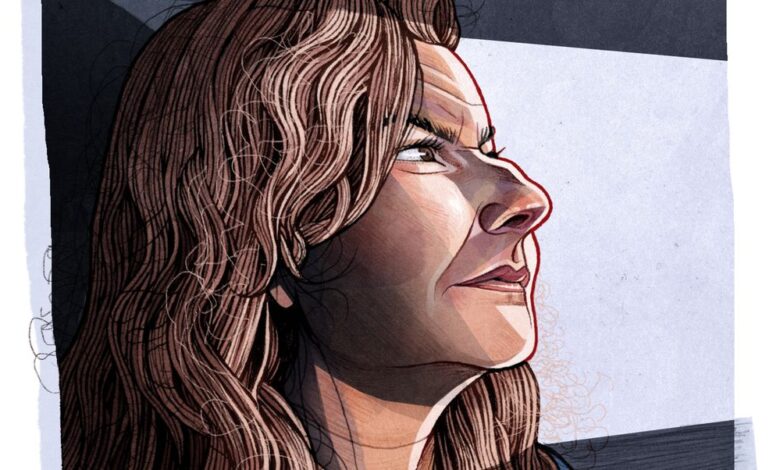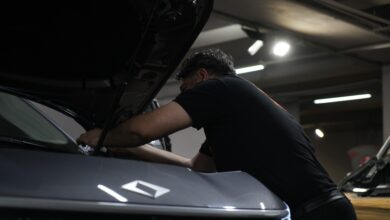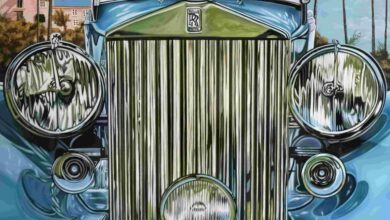Are Modern Headlights Too Bright?

From the May/June issue of Car and Driver.
I used to love driving at night. The landscape gets dreamy, the Botts’ Dots on L.A. freeways glow in empty lanes, and you feel like Pac-Man, eating up the miles. But these days, it’s feeling more like a game of laser tag. You’re zipping along, velvety darkness all around you, and then a Tesla comes up in the next lane, and your side-view mirror becomes an optical resonator beaming light directly into your left eye. While that dazzle fades, a Raptor turns left and melts your right eye. And as your optic remains ooze down your cheekbone, the oncoming traffic’s headlights enter the empty socket and burn a series of flaming double circles into your brain. Squinting through the afterimage, you just have to hope the road doesn’t turn before you can see again.
When Manfred Mann’s Earth Band covered Springsteen’s “Blinded by the Light” in 1976, U.S.-based runners in the night were still reeling from the recent legalization of rectangular headlights, which, little did they know, would soon become the brighter halogen, then the cold blue high-intensity-discharge lights of luxury automobiles, and eventually the retina- searing LEDs that even in low-beam mode have oncoming drivers flashing their brights and muttering curse words. And now there are actual lasers for lights. Seriously, the battles I see of cars flashing high-beams at each other sometimes make me wonder if they’re speaking in Morse code.
Limping home, a charred husk, I wonder whether I’m just getting old or if headlights have gotten too bright. Initial research was not flattering. “Problems with glare where the headlight may seem more intense is a common age-related vision issue,” said an American Optometric Association rep, who sent a helpful PDF about night driving. It included tips like keeping your windshield clean, blinking more, and eating kale for healthy macular pigment.
Dig a little deeper, and it seems a lack of salad and an excess of age are not solely to blame for complaints about headlight dazzle. Light is tricky to measure: There’s brightness, then there’s brightness spread over a distance, and then there’s the color of the brightness. But whichever measurement you choose—lumens, lux, candela, nits, Kelvin—LED headlights rate higher than old-fashioned halogens. So yeah, they are brighter, and it’s not just me, nor is it just the unrelenting passage of time.
A 2022 article by Becky McCall for the College of Optometrists in London has a whole section with survey results showing that even teen drivers are complaining of an increase in glare from oncoming and passing cars. We’re probably all noticing headlights more because most new vehicles come with LEDs standard, many owners of older cars are retrofitting them with aftermarket lights, and all of us are surrounded by more SUVs and trucks, which are perfectly positioned to shine lights into mirrors and faces.
Reddit groups, like the aggressively named r/fuckyourheadlights—29,000 members strong—share videos of offensively bright tailgaters and commiserate over going temporarily blind while behind the wheel. Occasionally, a pro-bright-light driver enters the chat, kicking off passionate discourse about whether one person’s better long-distance vision is worth blinding everyone around them. Tempers flare like the hot spot in your rearview mirror.
One solution could be adaptive headlights, which have been legal in Europe since 2006 and are in the slow process of NHTSA testing after finally being approved in 2022. But that’s just going to help future drivers. What about all the blinding lights on the road now? Do we just swear and suffer?
Not if the Soft Lights Foundation has its way. Founder Mark Baker currently has more than 58,000 signatures on a petition to ban LED lights not just in cars but in most public places. Banning all LEDs seems pretty extreme, but Baker believes they cause health issues beyond dazzling drivers, and he’s filed a lawsuit against the FDA for failure to regulate luminance in headlights and other LED applications. (At press time, the FDA had not yet responded to the lawsuit filed in January.) “The right light is basically back where it was,” he told me. “The tungsten filament, uniform distribution—a soft, gentle light.”
I wish Baker luck with his ambitious dreams of gentle light. In the meantime, I’m going to eat more kale.
Like a sleeper agent activated late in the game, Elana Scherr didn’t know her calling at a young age. Like many girls, she planned to be a vet-astronaut-artist, and came closest to that last one by attending UCLA art school. She painted images of cars, but did not own one. Elana reluctantly got a driver’s license at age 21 and discovered that she not only loved cars and wanted to drive them, but that other people loved cars and wanted to read about them, which meant somebody had to write about them. Since receiving activation codes, Elana has written for numerous car magazines and websites, covering classics, car culture, technology, motorsports, and new-car reviews. In 2020, she received a Best Feature award from the Motor Press Guild for the C/D story “A Drive through Classic Americana in a Polestar 2.” In 2023, her Car and Driver feature story “In Washington, D.C.’s Secret Carpool Cabal, It’s a Daily Slug Fest” was awarded 1st place in the 16th Annual National Arts & Entertainment Journalism Awards by the Los Angeles Press Club.



